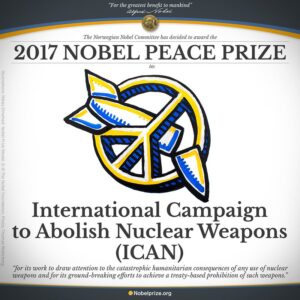How the resources below link to the Citizenship curriculum
Mainly GCSE, but also KS3:
- The UK’s relations with the rest of the world (especially via the UN).
- International law.
- Pressure groups and ‘actions citizens can take in democratic … processes to influence decisions locally, nationally and beyond’.
The Treaty on the Prohibition of Nuclear Weapons (TPNW) initiative via the United Nations, supported by civil society groups in the UK and elsewhere
What is the TPNW?
- The Treaty on the Prohibition of Nuclear Weapons opened for signatures in September 2017. It entered into force on 22 January 2021. As of August 2024 there are 93 signatories and 70 countries have ratified the Treaty.
- 122 UN countries had previously voted to adopt the Treaty, partly as a result of work by the International Campaign to Abolish Nuclear Weapons (ICAN, a global network comprising CND and many other organisations, which won the 2017 Nobel Peace Prize for its efforts).

Governments opposed to the initiative, and campaigners’ responses
- However, none of the nine countries with nuclear weapons voted for the Treaty, nor have they signed or ratified it. The UK made this statement explaining why, arguing that the (Nuclear) Non-Proliferation Treaty dating from the 1970s is sufficient and that the TPNW would not be effective.
- This House of Commons Library report gives more detail and context on the Treaty and the UK’s stance on it.
- Campaigners have put pressure on the UK government to embrace the Treaty, for example in this multi-signatory letter to The Guardian. In addition, towns and cities around the world have become ‘Global Ban Communities’ by pledging to support the Treaty, partly in order to put pressure on countries who haven’t supported it; Manchester was the first city in Europe to do so.
All the webpages above are suitable for higher-ability KS3 or GCSE students, although they could potentially be scaffolded for differentiation.
How to use these resources in your classroom
- The TPNW could be used as a case study for students to learn about the intersection between pressure groups, lobbying, and international law. In small groups, they could research an aspect of the process through which the Treaty came about (such as the role of pressure groups, the challenges of passing international law, and the opposition that the Treaty’s proponents faced), and present their findings to the rest of the class.
- Conduct a ‘spectrum’ or ‘barometer’ to stimulate a student discussion on – for example – whether the UK should sign the Treaty.
- Alternatively, or additionally, the class could debate how effective the Treaty is likely to be – in terms of facilitating nuclear disarmament – should it come into force.
About this webpage

This webpage is one of six collections of topic-specific resources that could be used as part of the Citizenship classroom and homework activities referred to in the ‘Additional information and guidance for Citizenship teachers’ insert of our Truman On Trial pack. To access the pages on the other five topics, click here.
If you’d like further advice on how to implement any of the teaching suggestions from the resources webpages, or the insert, just email peaceeducation@cnduk.org.